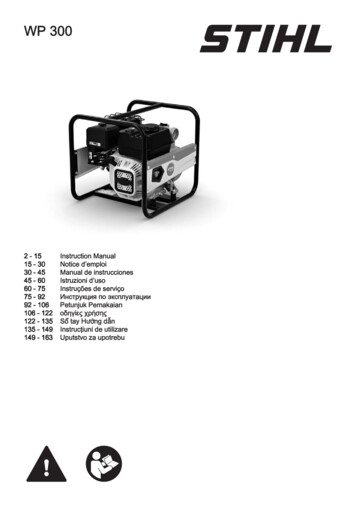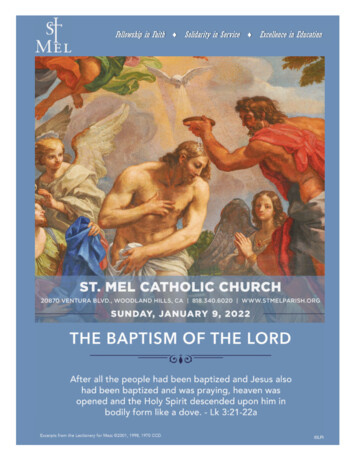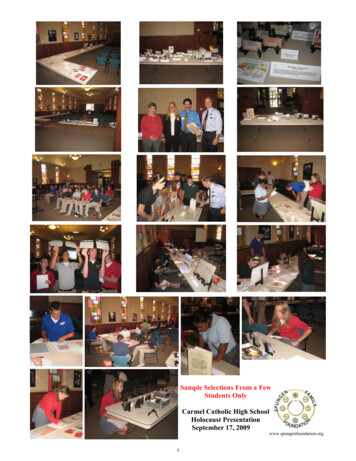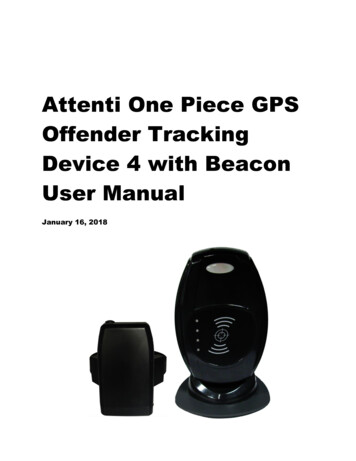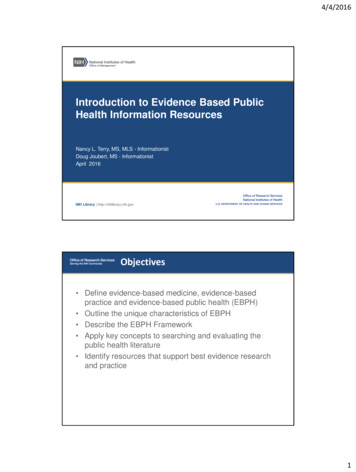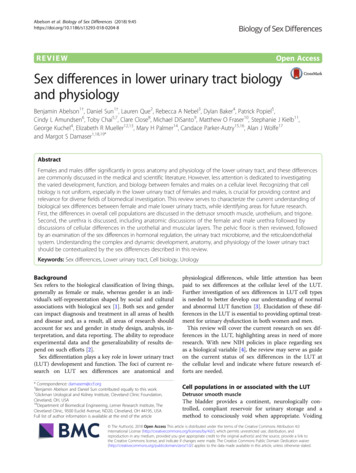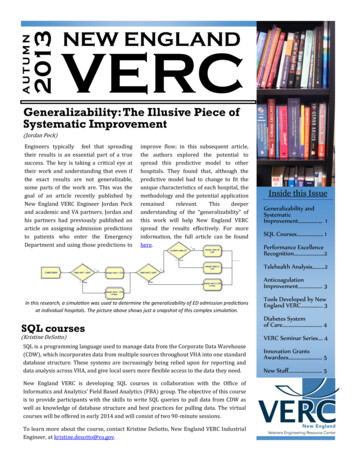
Transcription
2013autumnNEW ENGLANDVERCGeneralizability: The Illusive Piece ofSystematic Improvement(Jordan Peck)Engineers typically feel that spreadingtheir results is an essential part of a truesuccess. The key is taking a critical eye attheir work and understanding that even ifthe exact results are not generalizable,some parts of the work are. This was thegoal of an article recently published byNew England VERC Engineer Jordan Peckand academic and VA partners. Jordan andhis partners had previously published anarticle on assigning admission predictionsto patients who enter the EmergencyDepartment and using those predictions toimprove flow; in this subsequent article,the authors explored the potential tospread this predictive model to otherhospitals. They found that, although thepredictive model had to change to fit theunique characteristics of each hospital, themethodology and the potential g of the “generalizability” ofthis work will help New England VERCspread the results effectively. For moreinformation, the full article can be foundhere.Inside this IssueGeneralizability andSystematicImprovement . 1SQL Courses . 1Performance ExcellenceRecognition .2Telehealth Analysis .2AnticoagulationImprovement . . 3In this research, a simulation was used to determine the generalizability of ED admission predictionsat individual hospitals. The picture above shows just a snapshot of this complex simulation.SQL courses(Kristine DeSotto)SQL is a programming language used to manage data from the Corporate Data Warehouse(CDW), which incorporates data from multiple sources throughout VHA into one standarddatabase structure. These systems are increasingly being relied upon for reporting anddata analysis across VHA, and give local users more flexible access to the data they need.New England VERC is developing SQL courses in collaboration with the Office ofInformatics and Analytics’ Field Based Analytics (FBA) group. The objective of this courseis to provide participants with the skills to write SQL queries to pull data from CDW aswell as knowledge of database structure and best practices for pulling data. The virtualcourses will be offered in early 2014 and will consist of two 90-minute sessions.To learn more about the course, contact Kristine DeSotto, New England VERC IndustrialEngineer, at kristine.desotto@va.gov.Tools Developed by NewEngland VERC 3Diabetes Systemof Care 4VERC Seminar Series . 4Innovation GrantsAwardees . 5New Staff . 5
VA New England Receives Regional and NationalRecognition for Performance Excellence(Courtney Scala Smith)Dr. Mayo-Smith receives the2013 PiPEx Platinum AwardThis fall, VA New England Healthcare System was honored with the 2013Platinum Performance Excellence Award from Partners in PerformanceExcellence (PiPEx), a regional Baldrige-based award program servingMassachusetts and New York. In addition to the PiPEx Platinum Award, VISN 1also received a national Baldrige site visit. Applicants were rigorouslyevaluated by an independent board of examiners in seven areas defined by theBaldrige Criteria: leadership; strategic planning; customer focus; measurement,analysis and knowledge management; workforce focus; operations focus; andresults. VA New England was honored to be one of ten national applicants thatscoredhighenoughinVISN 1 Releases Video Showcasing theperformance maturity to be eligibleI CARE Values and 5 “Excellences”for this prestigious site visit.As part of its performance improvement system, VISN 1 conducts annualBaldrige-based organizational assessments to evaluate and accelerateprogress toward the mission of providing exceptional health care andservices to New England’s Veterans. The Baldrige Criteria provide anintegrated systems approach to organizational change, innovation, andsustainability, and reflect the leading edge of validated managementpractice.Click here to view a video released atthe PiPEx 2013 Baldrige Best PracticesSummit. The video showcases ourentire Network and the tremendousefforts of VA staff in demonstratingour I CARE Values in caring forVeterans.In VISN 1, there is a commitment to excellence that is supported by a strong culture of improvement. Congratulations toall Medical Centers and staff, and thank you for your commitment to continuous improvement and performanceexcellence! For more information about the PiPEx award, the Baldrige Program for Performance Excellence, or ourannual Baldrige-based organizational assessment, e-mail Joanne Puckett or Courtney Scala Smith.Academic Collaboration to AnalyzeTelehealth Expansion(Kyaani Robinson)New England VERC has sponsored several studentprojects that have applied systems engineering analysis tothe process of telehealth and its integration as a model ofcare. MIT graduate students conducted an enterpriseanalysis of the current state of telehealth in early 2012 andthis was followed by a more in depth study of theimplementation methods used to expand telehealthnationwide. VISN 1 telehealth leadership was theninterested to evaluate the return on investment andoverall benefits of telehealth locally for Video telehealth(CVT) and Store and Forward (SF) telehealth and isworking with a team from Worcester Polytechnic Institute.Some telehealth benefits could be explicitly measured indollar savings (tangible), including the cost of l2reimbursement, unique telehealth staffing, and trainingcosts. Quantifying other benefits for this analysis provedto be challenging due to the availability of data; thisresulted in intangible variables, including patient accessand satisfaction, decrease patient length of stay ofhospitalization, and mortality rate. The team utilized aDecision Making Multiple Attributes method to quantifyand evaluate these intangible benefits.Onerecommendation will be to investigate the variation thatwas found in cost per telehealth encounter between sitesin the VISN. The results of this analysis will play a crucialrole in VISN 1’s decision making process on telehealthissues, as funding support transitions from national (T21)to local medical centers at the end of FY14.
Anticoagulation Improvement(Angela Park and Tim Schmoke)On November 19, 2013, the VISN 1 Improvingand were allowed the opportunity to provide feedbackAnticoagulation Care Team held their quarterly face-toregarding strong practices and possible improvementface meeting at the Providence VA Medicalopportunities. Teams also reviewedCenter. Representatives from seven ofprocess maps from each site whicheight medical centers were in attendance asdepicted the follow up process forwell as representatives from researchtheir anticoagulation clinic. This gaveCenter for Healthcare Organization andparticipants the opportunity to seeImplementation Research (CHOIR) andhow other sites operate and toNew England VERC. Those in attendanceprovide feedback. To wrap up therotated through four breakout sessions: 1)day, there was a lively discussionDeveloping a Quality Assurance Plan/Usingregarding how to improve Time ina Clinical Reminder, 2) StandardizingTherapeutic Range (TTR). Many hadthe Use of Novel Anticoagulants, 3)great advice to offer, such asAttendees assess Providence’sstrong practices and opportunitiesStandardizing Warfarin Prescribingfollowing the recommended dosingfor improvementand 4) Standardizing Technician Roles.algorithm and holding monthlyDiscussions throughout the breakoutsmeetings to discuss complicatedwere very productive and provided impetus for thecases. It won’t be long until the first site in VISN 1 meetsproject’s next steps. Participants also spent time observingthe TTR goal of 70%!the operations of the Providence Anticoagulation ClinicTools Developed By New England VERCVirtual Meeting Tools(Kristine DeSotto)Process Wait Time Calculator(Jordan Peck)Virtual meetings can present many challenges fororganizers, facilitators, and attendees. To help managethe many different components of a virtual meeting,New England VERC developed the following tools:New England VERC has developed a simple tool that staffcan use when they are working on improving clinic flow.The tool, called a “Process Wait Time Calculator”, usesqueuing theory to determine the relationship betweenresources and the targeted wait time. Queuing Theory is amathematical methodto evaluate the flowswithin systems andmakedatadrivendecisions about thenumber of resourcesnecessary to reachcertain wait time goals.Alternatively, QueuingTheory can help setgoals for reductions inprocessing time orvariability while keeping staffing levels the same. Thesecalculations work in the background of the Calculator,while a clinic manager adds in their particular data to gettheir results. It enables a non-technical manager to utilizemore rigorous methods and improve the basis ofdecisions about staffing and wait times. Strong Practices for Virtual Meetings —providestipsfromexperiencedfacilitators in organizing and runningvirtual meetings Lync User Guide — demonstrates differentfeatures of Lync 2010, including settingup meetings, sharing content, andutilizing whiteboards and pollsAlso available on ourSharePoint site is a section onfacilitating virtual meetingsfrom Facilitation With Easeby Ingrid Bens and a sessionplanning template developedby Cindy Huggett, a virtualtrainings consultant.3
Diabetes Systemof CareNew England VERCSeminar Series(Kristine DeSotto)(Angel DeJong)New England VERC and VISN 1 clinical and research staff havecollaborated to develop a Diabetes System of Care, a model toidentify improvements in quality, patient experience andoutcomes. The work included a literature review, dataanalysis, and provider interviews, and an MIT student grouputilized lean enterprise analysis to determine opportunityareas within theSystem of Care.From this work,three pilot projectswere chartered.New England VERC resumed its SeminarSeries on November 8. Dr. Sangwon Yoon,Dr. Mohammad Khasawneh, and Dr. ChunAn Chou spoke about their research atBinghamton University.First, theyexplained how a variety of data miningtechniques can be used as patient riskprediction models. Then they showed howthese models can be used to forecast theprobability that a patient would bereadmitted to the hospital within 30 days.Applying these research findings in VAhospitals would improve care to Veterans,since the likelihood of them returning tothe hospital would decrease. Reducingreadmissions would also result in costsavings, and these additional funds couldbe used to improve other areas of thehospital.The first projectfocused on thepercent of diabeticretinal screeningscompleted on time,which relies onopen access to eyecare services. Atthe start of this project, the level of access for this screeningwas unknown. In collaboration with Office of Rural Health’sGeoSpatial Outcomes Division (GSOD), three maps weredeveloped. The Geomapping for Eye Care Services final reportfor this project, including maps, and lessons learned fromusing this method, is available on the New England VERCSharePoint site.The second project also focused on the retinal exam fordiabetic patients. Chart reviews, interviews, and an analysis ofthe clinical reminder for the diabetic retinal exam werecompleted and include a list of failure modes, or ways aprocess can fail to provide expected results. As a result of thisproject, New England VERC has published the Failure ModeAnalysis for the Retinal Exam for Diabetic Patients final reportand a guide to Understanding and Analyzing ClinicalThe next Seminar Series topic is “DiabetesE-Consults for Primary Care: Barriers andRecommendations”, and will be presentedby Dr. Pratik Parikh and Dr. JennieGallimore from Wright State University.The seminar will be on Friday, December13 from 12:00 to 1:00 EST.Email NewEnglandVERC@va.gov to beadded to the Seminar Series mailing list.Reminders.The final project was completed in collaboration with VISN 1Clinical Informatics with guidance from VISN 12’s Dr. MarkMcConnell. The project team developed a report to identify thepercent of diabetic patients at risk for hypoglycemia. This webreport has been transitioned to VISN 1 Primary Care and aclinical reminder to help identify these at-risk patients is beingdeveloped. A final report for this project will be completed thisSpring.4Dr. Sangwon Yoon, Dr. Chun-An Chou,and Dr. Mohammad Khasawneh;professors at Binghamton University
Awardees Announced for 2013-2014VISN 1 Innovation Grants!(Courtney Scala Smith)In September, the VISN 1 Improvement Resource Office (VIRO) announced the awardeesfor the 2013-2014 Innovation Grants program, with a total of eighteen grant recipientsreceiving individual grants ranging from 1,000 to 25,000. Each grant supports at leastone of VISN 1’s strategic goals by funding projects such as developing an evidence-basedapproach to tobacco cessation for Veterans; enhancing provider-patient communication;developing an electronic research management solution for improving the IRB reviewprocess; improving telemental health training for VISN 1 staff; and creating an onlineforum to connect Veterans to theirVISN 1 Strategic Goals: The 5 “Excellences”communities. Congratulations to all Excellence in Population Healthof the 2013-2014 Innovation Grants Excellence in Patient Experiencerecipients! If you have an idea for an Excellence in Financial Stewardshipinnovation project of your own, stay Excellence in Workforcetuned this spring for more Excellence in Service to Our Communitiesinformation on the 2014-2015 cycle.New StaffLori FopianoLori Fopiano, our newAdministrativeOfficer,brings diverse experienceto her role; previously, shehas worked in Laboratoryand Pathology, PublicAffairs, and, most recently,Mental Health at VABoston.This November, theNew England VERCparticipated in“Movember”. Men ofthe VERC sportedmustaches to raiseawareness of men’shealth.Elizabeth MayElizabeth May joinedNew England VERC inDecember 2013, afterspending three yearswiththePittsburghVERC.As a ProgramApplications Specialist,her projects will includeSQL and SharePoint.Stephanie LaneStephanie Lane, our newAdmin Specialist, shehas worked in MAS,PrimaryCareandMental Health. She isknowledgeable in HR,PIV, EL, Timekeeper andSupply Tech.New England VERCPrimary Business Address:150 S. Huntington Ave.Building 9Jamaica Plain, MA 02130www.newengland.va.gov/verc/For more information aboutNew England VERC, pleasecontact: Janis Hersh, Director Cliona Archambeault,Deputy Director Jim Schlosser, Director,VISN 1 ImprovementResources OfficeAngel DeJong, Editor5
well as knowledge of database structure and best practices for pulling data. The virtual courses will be offered in early 2014 and will consist of two 90-minute sessions. To learn more about the course, contact Kristine DeSotto, New England VERC Industrial Engineer, at kristine.desotto@va.gov. SQL courses (Kristine DeSotto)





